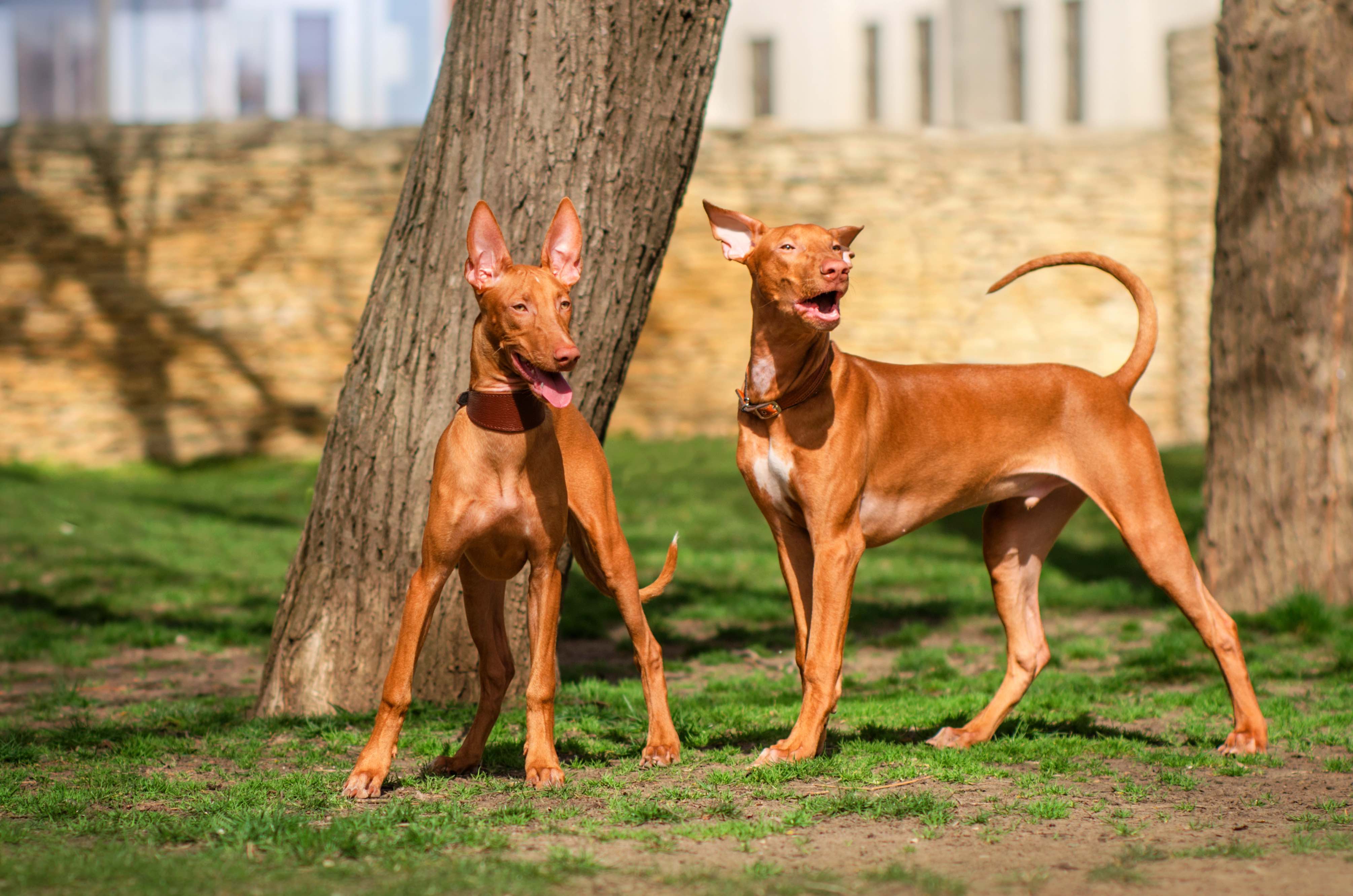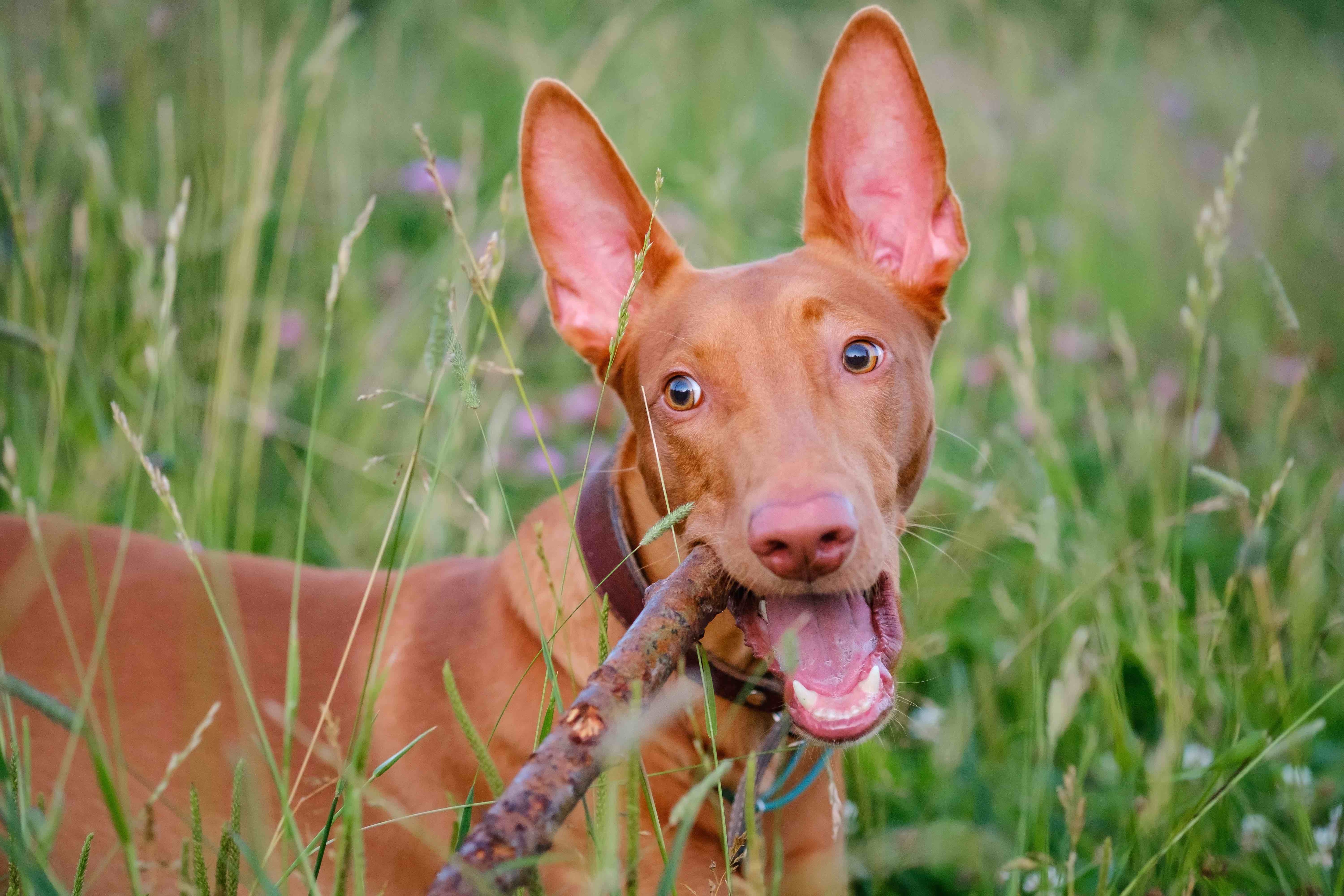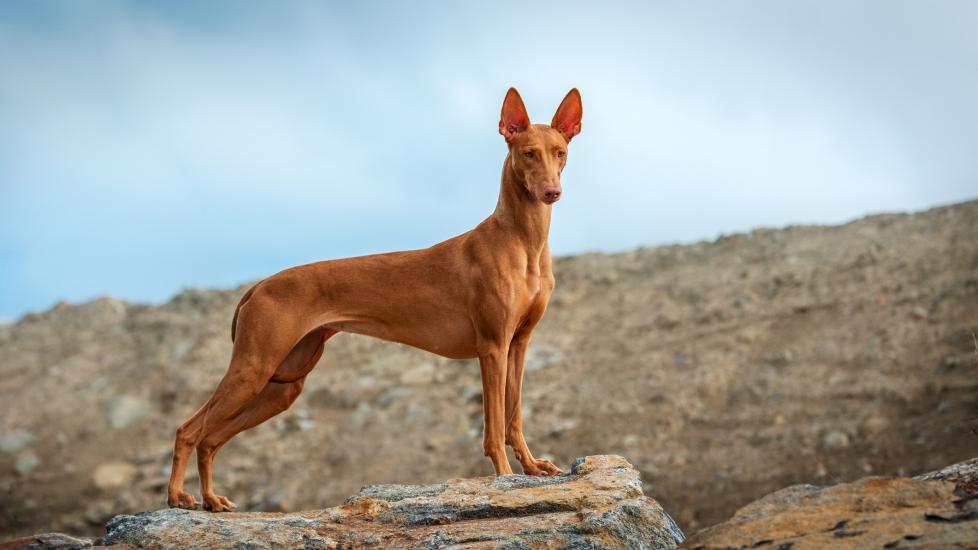Pharaoh Hound
The Pharaoh Hound is a unique dog breed with a regal appearance reminiscent of ancient Egypt. Elegant and graceful, this breed holds a mystic allure not only for the resemblance to the Egyptian god Anubis, but for the dogs’ unique ability to blush when excited.
The Pharaoh Hound is believed to have roots dating back to 4400 BCE Egypt, according to the Pharaoh Hound Club of America (PHCA), before being further developed in Malta. The American Kennel Club (AKC) officially recognized the breed in 1983.
Caring for a Pharaoh Hound
Resembling other sight hounds with a slim build, the Pharaoh Hound is a medium-sized dog that stands 21–25 inches tall and weighs 45–55 pounds. They have a statuesque presence that’s hard to overlook, with large ears, a slender muzzle, and long legs. Their coat is short and comes in shades of tan, chestnut, or golden-red.
The Pharaoh Hound’s temperament is friendly and sociable, making them great family dogs. They’re playful and have an energetic nature that calls for regular exercise to keep them healthy and happy. Grooming them is relatively easy due to their short and smooth coat.
Pharaoh Hound Health Issues
The average Pharaoh Hound lifespan is 12–14 years, about typical for medium dog breeds. They’re generally a healthy breed but may be predisposed to certain health issues. Pet insurance may be a good investment when bringing home a Pharaoh Hound puppy.
Elbow and Hip Dysplasia
Elbow dysplasia and hip dysplasia are both orthopedic conditions that can affect Pharaoh Hounds.
Hip dysplasia is a condition where the hip joint is unstable and loose, which can eventually cause arthritis and limited mobility. Similarly, elbow dysplasia is a condition where a dog’s elbow joint doesn’t fit together properly.
Both are inherited conditions that can also be exacerbated by other contributing factors, such as exercise habits, weight, and nutrition. Treatment for both can range from pain medications and joint supplements to surgery, depending on the severity.
Patellar Luxation
Pharaoh Hounds can develop luxating patella, an inherited condition where one or both of the kneecaps (patellas) pop in and out of place (luxate).
Although patellar luxation is not considered a painful condition, it may cause the dog to favor one leg and can also predispose them to other knee injuries (such as a cranial cruciate ligament tear) and arthritis. Depending on the severity, surgical correction may be recommended to prevent further injury and improve quality of life.
The average Pharaoh Hound lifespan is 12–14 years, about typical for medium dog breeds. They’re generally a healthy breed but may be predisposed to certain health issues.
Eye Disorders
Progressive retinal atrophy (PRA) is a group of degenerative diseases that affect the retina (the light-sensitive layer of the eye), eventually causing blindness.
Night blindness is often the first sign of the most common form of PRA. This will progress to a complete loss of vision. PRA is an inherited disease that affects Pharaoh Hounds as a result of both parents carrying the gene, even though the parents may not show signs of it themselves.
While this disease cannot be prevented or treated, there is a DNA test that can screen for the defective gene in potential carriers.
Ultimately, monitoring a Pharaoh Hound’s routine activities for changes and ensuring regular eye examinations by a veterinarian are best for early detection.
Cancer
This breed has an elevated risk for certain types of cancer, including hemangiosarcoma, mast cell tumors, and mammary cancer. These cancers affect different areas of the body, and regular health screenings are important because early detection and treatment can significantly affect your pup’s prognosis.
What To Feed a Pharaoh Hound
A balanced diet rich in proteins, healthy fats, and carbohydrates is essential for Pharaoh Hounds. A food that meets the standards set by the Association of American Feed Control Officials (AAFCO) for the dog’s current life stage (puppy, adult, or senior) is best.
It’s always recommended to consult with your veterinarian for specific dietary recommendations for your pet.
How To Feed a Pharaoh Hound
Feeding an adult Pharaoh Hound two to three small meals a day is recommended to maintain their energy level. Pharaoh Hound puppies may require three to four small meals a day. Using a slow-feeder bowl can promote better digestion and provide some enrichment during mealtime.
How Much Should You Feed a Pharaoh Hound?
The amount of food to feed your Pharaoh Hound will vary based on their age, size, activity level, and health. The packaging on your AAFCO-approved dog food will provide guidance on serving sizes. But for the best advice on how much to feed your Pharaoh Hound, talk to your veterinarian.
Nutritional Tips for Pharaoh Hounds
While a well-balanced diet provides all the nutrition a Pharaoh Hound needs, supplements like omega-3 fatty acids can support skin and coat health, and glucosamine can be beneficial for joint health.
Consult with your veterinarian before starting your dog on any supplements.
Behavior and Training Tips for Pharaoh Hounds

Pharaoh Hound Personality and Temperament
Pharaoh Hounds are good-natured, loving, and get along well with children. They’re extremely playful dogs that must have engaging activity every day, from informal backyard play to organized dog sports. While they’re a good fit for active families, well-exercised Pharaoh Hounds are pretty laid-back at home.
Pharaoh Hound Behavior
As sight hounds, Pharaoh Hounds have been bred to hunt based on sight. This means they have a strong prey drive and can be highly responsive to small, fast-moving objects or animals. For this reason, it’s important to keep them in a fenced yard or on a leash while outside to prevent them from chasing critters that may catch their attention. The breed club recommends a 6-foot fence for Pharaoh Hounds.
Pharaoh Hounds can also be very vocal dogs, especially when excited or during play.
Pharaoh Hound Training
Like many sight hounds, Pharaoh Hounds are bred to think and act independently, the breed club says. They require patience with training, though the breed is also intelligent and eager to please their people, which means they can pick up cues quickly with positive reinforcement.
Make sure training is done somewhere free of distractions. If you’re working on cues in your backyard, for example, your training session will be derailed by a passing squirrel.
Fun Activities for Pharaoh Hounds
-
Nose work
-
Frisbee®
Pharaoh Hound Grooming Guide
Thanks to their short, fine coat, Pharaoh Hounds are low-maintenance in terms of grooming.
Skin Care
Skin care for the Pharaoh Hound can vary depending on the individual dog’s needs. However, the breed typically does not have sensitive skin. Regular checkups with your veterinarian can help ensure no skin issues are developing.
Coat Care
Pharaoh Hounds do shed, but not as much as many other breeds. A weekly brushing is usually sufficient to remove dead hair and keep their coat looking sleek and shiny. This breed only needs a bath when they get dirty or smelly, which is rarely.
Eye Care
Because Pharaoh Hounds are susceptible to PRA, pet parents must watch for any changes in their dog’s eyes or vision. If you notice anything like cloudiness, discharge, or if your dog seems to have trouble seeing (for example, if they’re bumping into things or seem to get lost at night), contact your veterinarian.
Pharaoh Hounds may also develop normal tear staining, which can be cleaned with a veterinary-approved wipe.
Ear Care
Routine ear cleaning with a veterinary-approved cleanser can help prevent infections. Ask your vet how often you should clean your dog’s ears.
Considerations for Pet Parents

Before bringing home a Pharaoh Hound, understanding their need for exercise, social interaction, and basic grooming is crucial.
Ideal homes for a Pharaoh Hound have a spacious, securely fenced yard with an active and attentive family. They do well with children and other dogs, but homes with cats and other small animals may be tricky to manage due to their prey drive. Introductions to cats and pocket pets need to be done slowly and properly.
Pharaoh Hounds don’t require much grooming, and they are considered to be a healthy breed.
Pharaoh Hound FAQs
Is a Pharaoh Hound a good family dog?
Yes, Pharaoh Hounds have a patient and gentle nature with children and other dogs, making them excellent family pets.
Are Pharaoh Hounds expensive?
The Pharaoh Hound price can range widely, but they are considered to be a more expensive breed due to their rarity. You can expect to pay anywhere between $1,500 and $2,500 for a Pharaoh Hound puppy.
How are Pharaoh Hounds, Basenjis, and Ibizan Hounds different?
Pharaoh Hounds are sometimes confused with Basenjis or Ibizan Hounds. The three ancient breeds share a similar sleek appearance, but they’re each different in size and origin:
-
Pharaoh Hounds stand 21–25 inches tall, weigh 45–55 pounds, and originated in Egypt.
-
Basenjis are just 16–17 inches tall, weigh up to 24 pounds, and are thought to have originated in Libya.
-
Ibizan Hounds are the tallest, at nearly 28 inches in height. They also weigh 45–50 pounds and originated in Egypt. But while Pharaoh Hounds can have small white markings, Ibizan Hounds can be all-white or have large white markings on their red fur.
Featured Image: Hanna Dymytrova-Kaihila/iStock / Getty Images Plus via Getty Images
